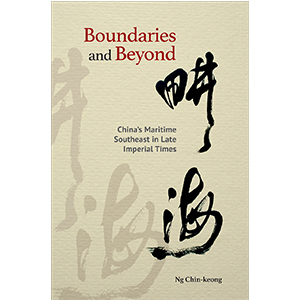Boundaries and Beyond: China’s Maritime Southeast in Late Imperial Times
Using the concept of boundaries, physical and cultural, to understand the development of China’s maritime southeast in late Imperial times, and its interactions across maritime East Asia and the broader Asian Seas, these linked essays by a senior scholar in the field challenge the usual readings of Chinese history from the centre. After an opening essay which positions China’s southeastern coast within a broader view of maritime Asia, the first section of the book looks at boundaries, between “us” and “them”, Chinese and other, during this period. The second section looks at the challenges to such rigid demarcations posed by the state and its existence in the status quo. The third section discusses movements of people, goods and ideas across national borders and cultural boundaries, seeing tradition and innovation as two contesting forces in a constant state of interaction, compromise and reconciliation.
This approach underpins a fresh understanding of China’s boundaries and the distinctions that separate China from the rest of the world. In developing this theme, Ng Chin-Keong draws on many years of writing and research in Chinese and European archives. Of interest to students of migration, of Chinese history, and of the long term perspective on relations between China and its region, Ng’s analysis provides a crucial background to the historical shared experience of the people in Asian maritime zones. The result is a novel way of approaching Chinese history, argued from the perspective of a fresh understanding of China’s relations with neighbouring territories and the populations residing there, and of the nature of tradition and its persistence in the face of changing circumstances.
RM150.00
Out of stock
Description
Using the concept of boundaries, physical and cultural, to understand the development of China’s maritime southeast in late Imperial times, and its interactions across maritime East Asia and the broader Asian Seas, these linked essays by a senior scholar in the field challenge the usual readings of Chinese history from the centre. After an opening essay which positions China’s southeastern coast within a broader view of maritime Asia, the first section of the book looks at boundaries, between “us” and “them”, Chinese and other, during this period. The second section looks at the challenges to such rigid demarcations posed by the state and its existence in the status quo. The third section discusses movements of people, goods and ideas across national borders and cultural boundaries, seeing tradition and innovation as two contesting forces in a constant state of interaction, compromise and reconciliation.
This approach underpins a fresh understanding of China’s boundaries and the distinctions that separate China from the rest of the world. In developing this theme, Ng Chin-Keong draws on many years of writing and research in Chinese and European archives. Of interest to students of migration, of Chinese history, and of the long term perspective on relations between China and its region, Ng’s analysis provides a crucial background to the historical shared experience of the people in Asian maritime zones. The result is a novel way of approaching Chinese history, argued from the perspective of a fresh understanding of China’s relations with neighbouring territories and the populations residing there, and of the nature of tradition and its persistence in the face of changing circumstances.
Publisher: NUS Press
Hardback
2016
ISBN: 9789814722018






